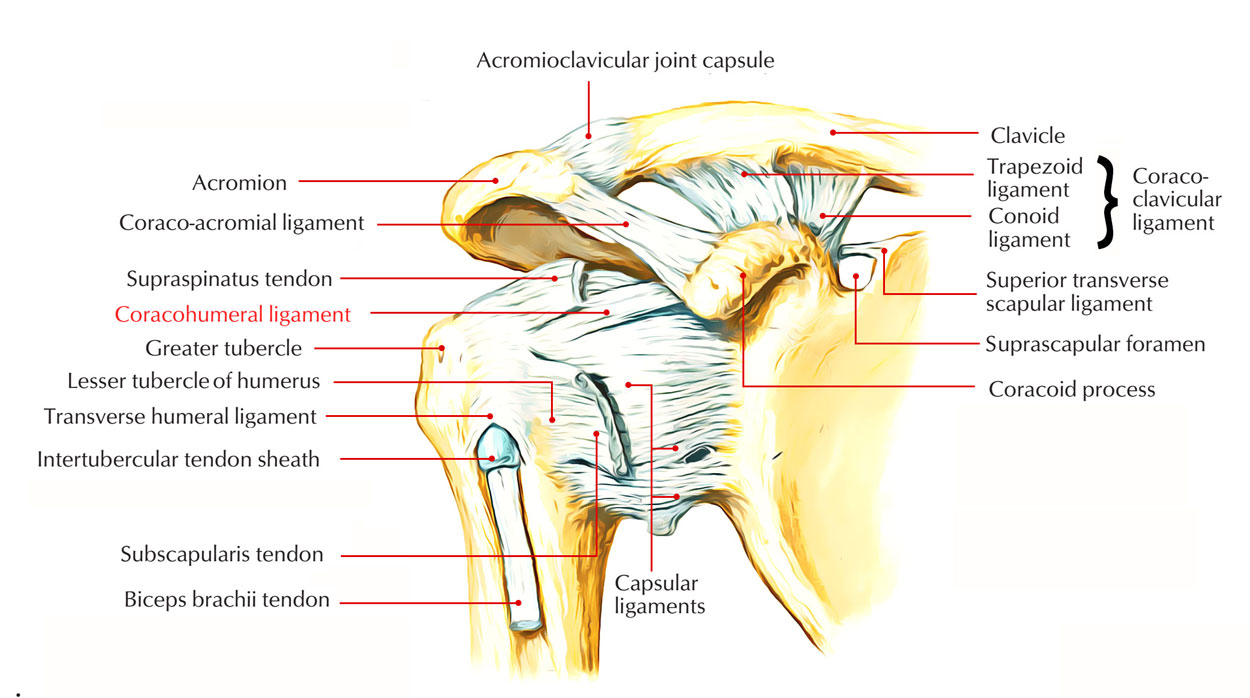Coracohumeral ligament is a strong strap of fibrous tissue that enters from the base of the coracoid process to the anterior element of the greater tubercle of the humerus.
Origin of Coracohumeral Ligament
- Coracohumeral ligament enters obliquely downwards and laterally to the front of the greater tubercle of the humerus, where the coracohumeral ligament mixes with the tendon of the supraspinatus muscle and emerges from the lateral border of the coracoid process.
- Coracohumeral ligament has two bands, anterior and posterior, that enter into the lesser and greater tuberosities of the humerus respectively.
- Coracohumeral ligament is totally connected to the capsule by its posterior and lower border; however its anterior and upper border provides a free edge, which overlies the capsule.

Coracohumeral Ligament
Insertion of Coracohumeral ligament
- The coracohumeral ligament courses from the coracoid process into the interval, merging with the interval capsule.
- Combining and merging with the anterior limit and superficial/deep fascial fibers of the supraspinatus anteriorly, this capsule-ligament complex extends superiorly.
- The interval capsule and ligament job laterally to enter on the greater and lesser tuberosities as well as extend inferiorly to the superior limit of the subscapularis.
Functions of Coracohumeral Ligament
- The coracohumeral ligament since of its position, it has the ability to strengthen the anterior and posterior limits of the rotator interval. It covers from the base of the lateral coracoid to the greater tuberosity.
- The reported structural characteristics of the coracohumeral ligament suggest that in stabilization at the glenohumeral joint it can play a considerable function.
- When the arm is at the side in external rotation, the coracohumeral ligament plays some function in superior stability of the joint and is an essential consider inferior stability.
- On top of that, the coracohumeral ligament acts to support against anterior translations of the humeral head, in external rotation, as anteriorly directed loads are applied to the glenohumeral joint.
- The coracohumeral ligament tightens up with increasing external rotation, it likewise serves to examine this motion.
Actions of Coracohumeral ligament
- It has actually been recommended that by the superior capsule, coracohumeral ligament, and inferior glenohumeral ligament, the down pull of gravity on an adducted arm is counteracted mostly.
- While the arm is abducted, the primary limiting force is the inferior glenohumeral ligament and the limiting force is moved to the inferior structures.
- The coracohumeral ligament checks lateral rotation throughout arm elevation in between 0° and 60° since the coracohumeral ligament lies anteriorly to the vertical axis on which the humerus turns axially.
- When the humerus, in a setting of neutral rotation, rises in the sagittal plane, the activity is restricted to roughly 75° by the coracohumeral ligament.
- For elevation to continue, the humerus is medially turned and approaches the scapular plane by the by the vibrant stress of this ligament.

 (62 votes, average: 4.63 out of 5)
(62 votes, average: 4.63 out of 5)